
This article originally appeared in The Washington Post
This rain — relentless, chilling, downright vengeful — wasn’t in the brochure. I am sitting on the gunwale of a dive boat off the French Polynesian atoll of Fakarava about to back-roll into a tropical sea famous for its abundance of sharks. I’m with two other divers and a guide in Tumakohua Pass, one of the two major breaks in this necklace of coral where the ocean feeds a 37-by-14-mile lagoon.
Swells pitch the boat as the rain turns horizontal. We are only a few hundred yards from shore, but the dock from where we departed is barely visible through the gale. At our guide’s signal, we drop from the maelstrom into the blue calm.
Fakarava is one of five atolls in French Polynesia, a collectivity of 118 islands cast across the South Pacific Ocean like unconfirmed rumors. The best known of these, and the territory’s commercial and cultural center, is Tahiti. I came to these islands to dive and in hopes of finding remnants of the ancient Polynesian culture, a playful, kind, egalitarian ethos exquisitely captured in David Howarth’s book “Tahiti: A Paradise Lost.”
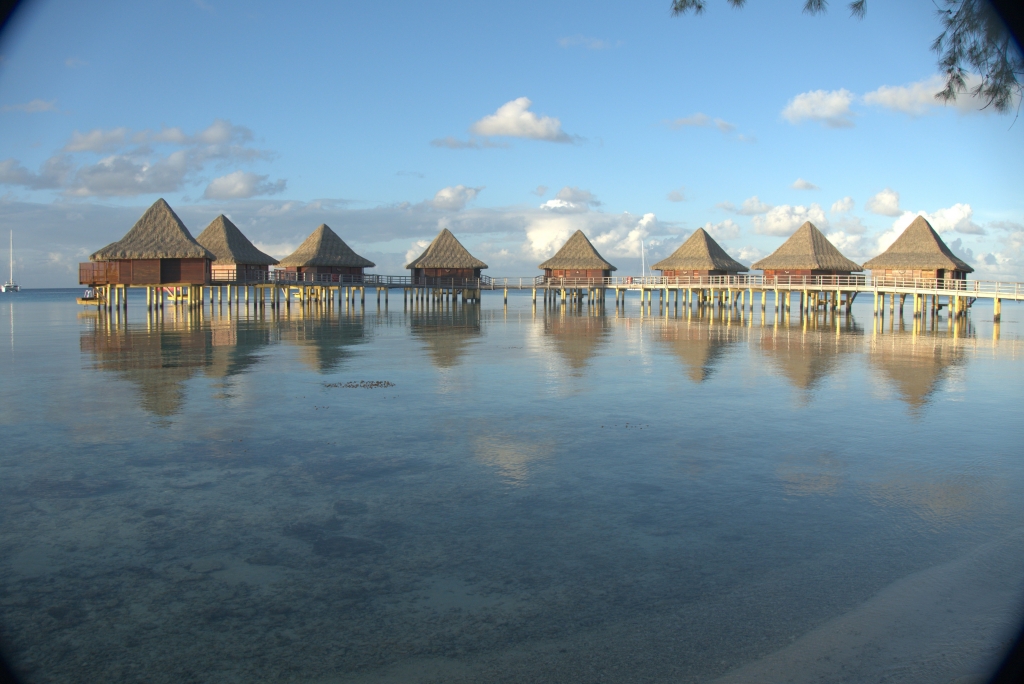
First things first. As we drop past 50 feet, I see them, dozens of gray reef sharks gliding along a wall of coral, at once sleek, powerful, beautiful and (sure) a little unnerving. They come to feed on the buffet of species in the pass and have only grown in number since 2006, when the territorial government established a shark sanctuary here. Experts estimate the local shark population in the hundreds.
They feed at night, so we’re seeing them in a relatively passive state, although whenever I approach one for a photo, it bolts into the dreamy blue background. Our guide, Gils — lanky, dark-featured, serene — drifts meditatively, perking up only at the appearance of a school of small skipjack tuna. My focus swivels from them to the sharks to the organic brilliance of the coral to a massive green-and-blue humphead wrasse, a fish that can reach 400 pounds, silhouetted in the stormy light above.
We barely have to kick at all because the current is escorting us back toward the boat dock in the village of Tetamanu (population: 40), where I’d arrived the day before after a 90-minute boat ride from the airport in the slightly larger town of Rotoava. There is no other way to get here, and no cars in Tetamanu, either; all travel is by boat, foot or fin, across, into or adjacent the infinite acreage of radiant water.
In fact, take away the Yamaha outboards and a few other modern trappings, and the place probably looks a lot like it did when the Polynesians first settled here in A.D. 500 after paddling or sailing canoes across immense expanses of ocean. They navigated by wayfinding, dividing the horizon into 16 sections and reading wind, waves, currents, and the movements of birds, fish and stars, an even more remarkable achievement when one sees how tiny and tentative this atoll appears on a map, engulfed by the Pacific Ocean.
Tetamanu, perhaps especially in the driving rain, feels like the end of the Earth, and that’s a big part of the allure, says Vaiete Maltby, who manages the Motu Aito guesthouse, a collection of eight wood-and-thatch bungalows where I’m staying. (“Motu” is the Tahitian word for islet, and Fakarava, like most atolls, is made up of dozens to hundreds of them.)
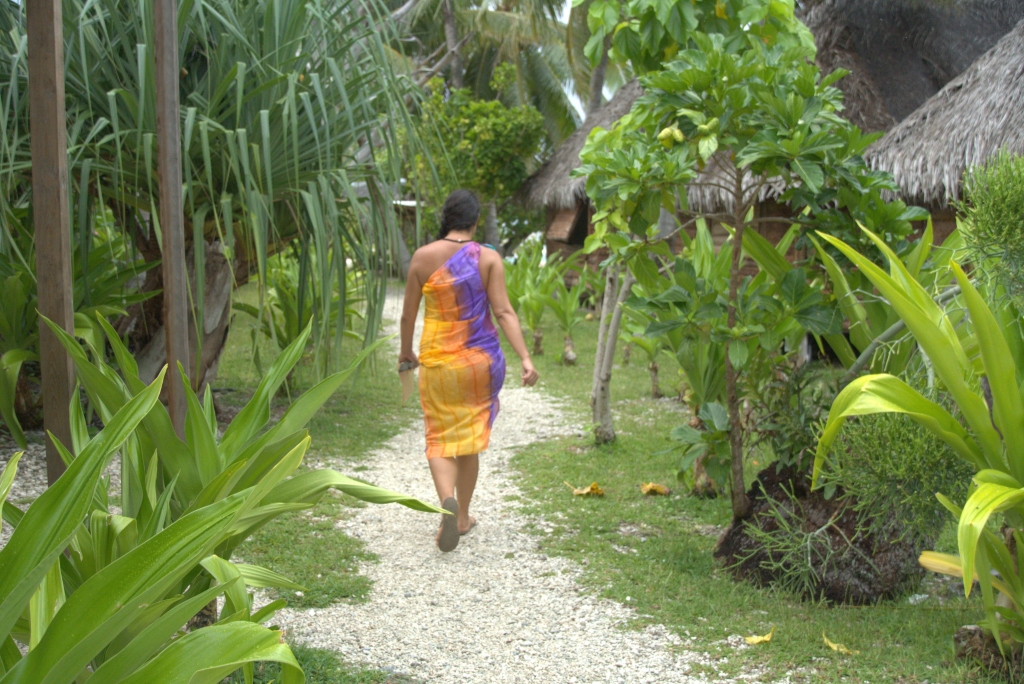
“People say they come here to disconnect, and most of them do,” aided occasionally by power and WiFi outages in this isolated spot, she says. “But you’ll also connect: with nature, yourself, whoever you’re with.” We’re exploring the village with the Motu Aito’s only other guests, Teva Nierding, a Tahitian weather forecaster, and his cousin Cindy Cridland, an insurance agency secretary. I’m connecting with Teva — a gentle soul with a buoyant love of the natural world — but I still blame him for the rain. We pass the town dock, with the dive center and restaurant, where a cook is tossing scraps to a frenzying shiver of sharks, and walk a grassy lane, past a cluster of bungalows and the ruins of a colonial-era city hall and prison. (Tahitians had no formal legal code, and no known inclination to lock people up, before Europeans arrived.)
The lane ends at the one remnant that has been kept up, an 1830s Catholic church, featuring a mother-of-pearl altar and a sea-blue ceiling. The sturdy construction, ornate decor and ambient light filling the nave are undeniable, but so is the history: In 1819, after finally winning converts to Christianity on Tahiti, English missionaries banned just about everything that made the natives happy — song, dance, play acting, casual sex, surfing and even tattooing, a kind of pictorial history that Polynesians use to summarize their life stories. These practices were gradually re-legalized starting in 1976.

The next day, I head back north for a tour of Rotoava with Enoha Pater, a guide who greets me at the boat dock wearing a turquoise pareo (wrap) around his waist and little else. He’s a tanned, paunchy 51, with a curly grayish-blond ponytail and the air of a man who lives worry-free in paradise. A former airport manager and fire chief for Rotoava, Enoha makes his living guiding and selling art — ink-on-canvas drawings, driftwood carvings and shell-based pieces that adorn the open-air, lagoon-front house he shares with his wife, Cecile, and nine dogs.AD
“This island has two rental cars, three scooters, two nurses and no doctor; everything serious, we give to the shark,” he says with a smile as we hit 80 mph on a dirt road in his 2012 Saab SUV. He speaks English with an Asian cadence, having learned English and Japanese simultaneously while working at a Club Med in Moorea.
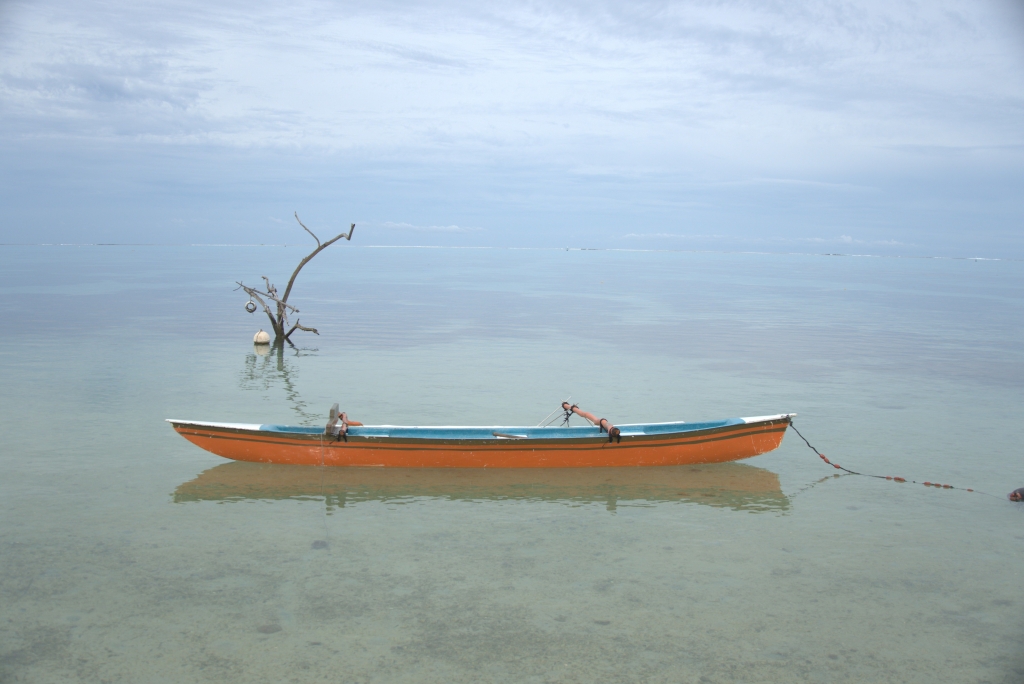
We stop in on a family-run coconut oil operation — one of the main industries here, along with farming the oysters that produce black pearls — then wend through stands of kahaia, tohonu and aito trees while Enoha tells me about plucking lobsters off the reef at low tide (but only during the first-quarter moon) and surfing the legendary wave at Teahupoo, Tahiti, where he was drubbed on the reef and broke his arm. We stop to snorkel at a secluded arc of sugar-white sand framed by swaying palms and the pearlescent lagoon. A sailboat anchored offshore is the only other sign of human life.
The back road ends at a sprawling cape of beached coral that marks the west side of Garuae Pass, at a mile wide the largest pass in French Polynesia. Again, that end-of-the-Earth aura, broken only by a dive boat heaving on lapis swells outside the reef, and my urge to get back underwater to commune with the rainforest of life.
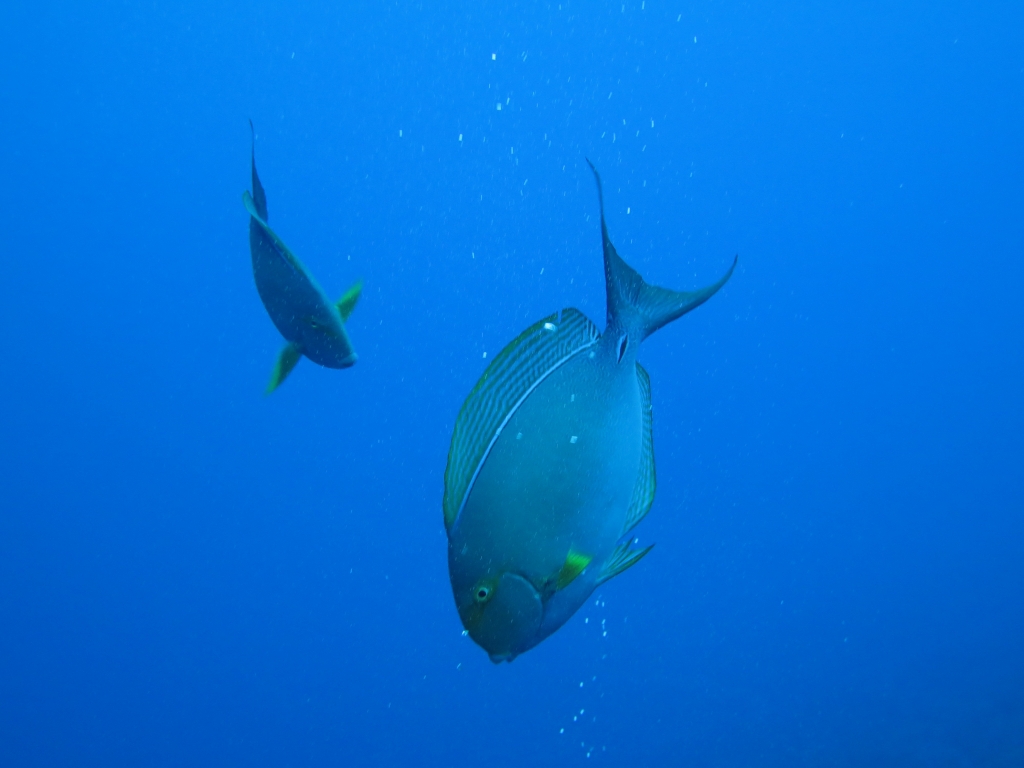
I hop a short flight to another wispy atoll, Rangiroa, and alight at the Kia Ora Resort & Spa, a dreamy property planted on the sandy shores of French Polynesia’s biggest lagoon. The sun comes out, casting its magic on a preposterously appealing scene — thatch bungalows built over the lustrous water, an outrigger paddler gliding across the horizon line, a waiter carrying umbrella drinks to bronzed tourists in an infinity pool.
The Kia Ora is also a five-minute boat ride from the main attraction here: the diving in Tiputa Pass, famous for its vibrant reef and a family of dolphins known to approach divers.
“Oh, sometimes they come right up to you,” Magali Bazzano tells me on the porch of the on-site dive center. “Rub their bellies; they like it. Just don’t do that with the hammerhead sharks.”
Magali carries a confidence belying her tiny stature, and her story, captured in an intricate tattoo on her right shoulder, hints at why. Stationed in Ivory Coast with the French army, she watched five friends die when a militant bomb struck the base.
“I came here on travel, met my lover and said I would return,” she tells me. “Six years later, I did. I am here. I am happy.”
I am, too, especially when I see the hypnotic cerulean glow of the sea and the dive boat docked at the end of an overwater walkway. I join a honeymooning couple and a crew of scuba journalists — all from Japan — for the short ride through Tiputa Pass, and we splash into the mesmerizing water. To be honest, I don’t want to belly-rub a dolphin, even a wild one; there’s something theme-parky about it, and maybe a sign that these revered animals are sinking to our level.
Good thing, then, that we see none on two dives, nor any hammerheads. Just a South Pacific coral reef pulsing with a carnival of color, including a rare sighting of a free-swimming moray eel, a hawksbill sea turtle, and immense schools of snapper, convict tangs and jacks.
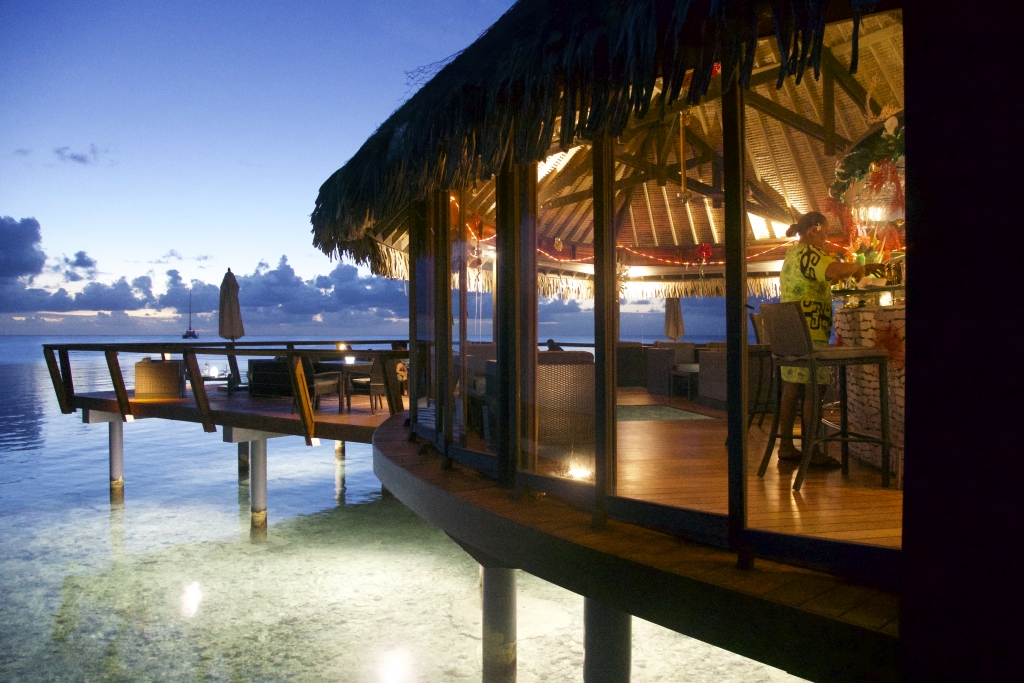
The bar of the Kia Ora Resort in Rangiroa takes on its own glow at sunset. Guests can view the abundant sea life either over the railings or through a section fo the interior floor that’s made of glass. (John Briley)
Back at the Kia Ora, I paddle one of the resort’s outrigger canoes toward the town dock — which, with the adjacent dive shop and two restaurants, is the center of action around here — and beach on a stretch of sand. I’m walking through a grove when I come upon three teen boys drinking beers. Howarth wrote of 18th-century Tahitians: “They did not need to be told to love their neighbors; everyone did, and when they met strangers they expected them to be very much like themselves, and instantly lovable.”
Three centuries have brought a lot of change, but I take a chance and nod hello. They offer me a beer (accepted) and other intoxicants (declined), and I take a seat on a tree stump. Between their halting English and my embarrassing French, aided by cellphone photos on both sides, we swap stories of our lives. They insist I take another beer when I leave.
One can be tempted in remote yet populated places like this to assume there’s action just around the next corner. And one afternoon on a rented scooter, I go looking for it, riding west to swales of beached coral at Avatoru Pass, site of occasional pro surfing competitions. All quiet there, as it is around the few lagoon-front resorts I pop into. I see flashes of activity off the main road — local kids riding bikes, a fisherman selling two beautiful, glistening tuna and a boatload of snorkelers unloading at a dock — but that’s the extent of it. This isn’t Miami Beach, and that’s a wonderful thing.
Besides, action is in the heart of the beholder. After dinner, I walk away from the soft glow of the Kia Ora, across the unlit road and into the pitch-black night of the oceanside beach. To a soundtrack of breaking waves and clinking shells and coral, I look up into the spangled dome of stars, so many and so bright, and gaze until my neck aches.AD
The next morning on a solo snorkel trip through the pass, I roll from boat into ocean and see the pod — a mom and a calf not 10 feet in front of me and, below them, five other dolphins. They seem suspended, as if frozen in amber, but within seconds, they’re rocketing into the dark blue (no bellies offered). I kick to try to line up a photo, but it’s pointless.
I spend my final two days on the island of Moorea, a 30-minute ferry ride from Papeete, the main city on Tahiti and the bustling capital of French Polynesia. Beyond Papeete’s congestion, colorful market, bars, shops and busy industrial port, much of Tahiti — and all of Moorea — look very much like the brochure, with reef-fringed coastline and forested hills that sweep up to pinnacles of jungle green.

From the ferry dock in Moorea, I follow the island’s coastal road past fruit stands, modest homes, black pearl shops, tattoo parlors and cafes, tracing the bays where Captain Cook and other emissaries of Britain, Spain, France and Russia dropped anchor. The French claimed these islands while their colonial rivals were distracted or uninterested (long story; read Howarth), and today Tahiti and Moorea in particular flaunt a France-meets-old-Hawaii vibe.AD
I taste it in the poisson cru (raw sushi-grade tuna with coconut milk) at Le Lézard Jaune Café, an open-air roadside restaurant in Moorea where the flamboyant owner, Dominique, flits among the tables in a blazing floral top and pants. I see, hear and smell it in the Papeete market, stalls of fresh fish adjacent island-style carvings and weavings and, outside, gaily colored fabrics alongside a table of pastries overseen by a Gallic baker in a towering white chef’s hat. And it’s on full display on the beach in front of Les Tipaniers hotel, bar and restaurant in Moorea, where French families — Speedos, body oil, cigarettes and delightfully unattended children — sear in the sun.
My closest brushes with old Tahitian culture come at the Papeete ferry dock, where an old woman, perhaps confused by my attempts to engage her in conversation, smiles warmly while offering me her lei flower necklace, and in supermarkets and shops, where staff and customers alike seem content, peaceful and unhurried.
In the waning hours of my trip, before a ferry ride back to Papeete and a taxi to the airport, I join a guide for a surf session. He picks me up from a beach in his boat, motors us over the luminescence and ties off to a mooring buoy. The waves, which appeared small from afar, rumble over the reef, sections of which jut above the water line. I swallow dryly as we paddle toward the lineup. But soon I remember where I am and imagine how I’d feel if I squandered this fantasy. I turn, paddle hard and drop into a glassy, head-high wave, riding a sliver of the South Pacific toward the setting sun as the colorful blur of sea life races by beneath the board.
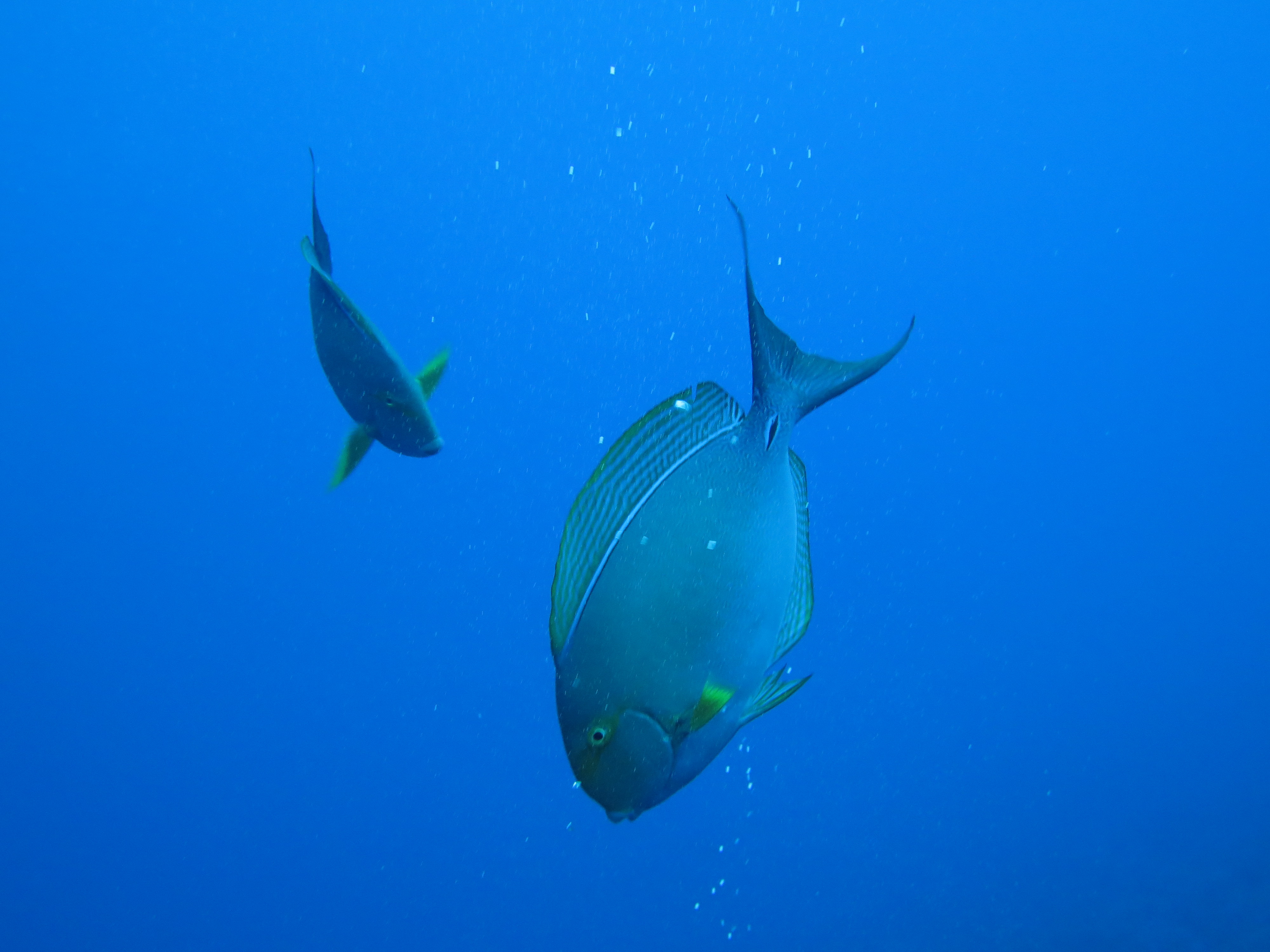
Comments